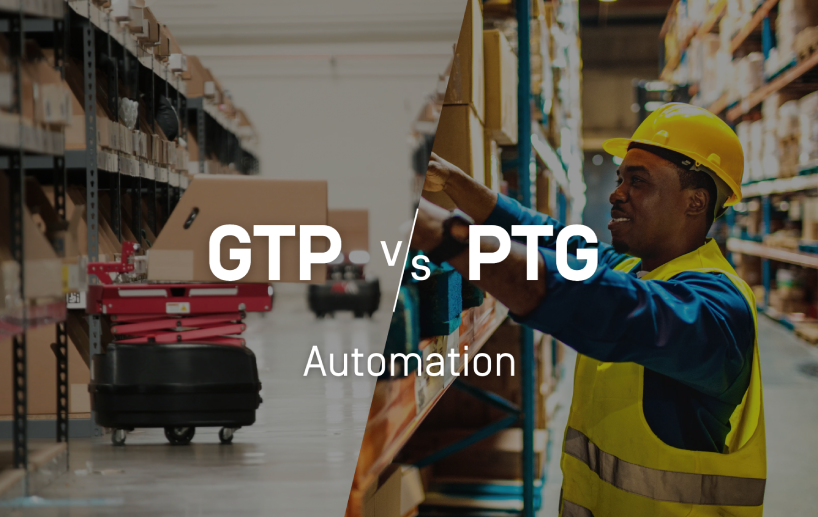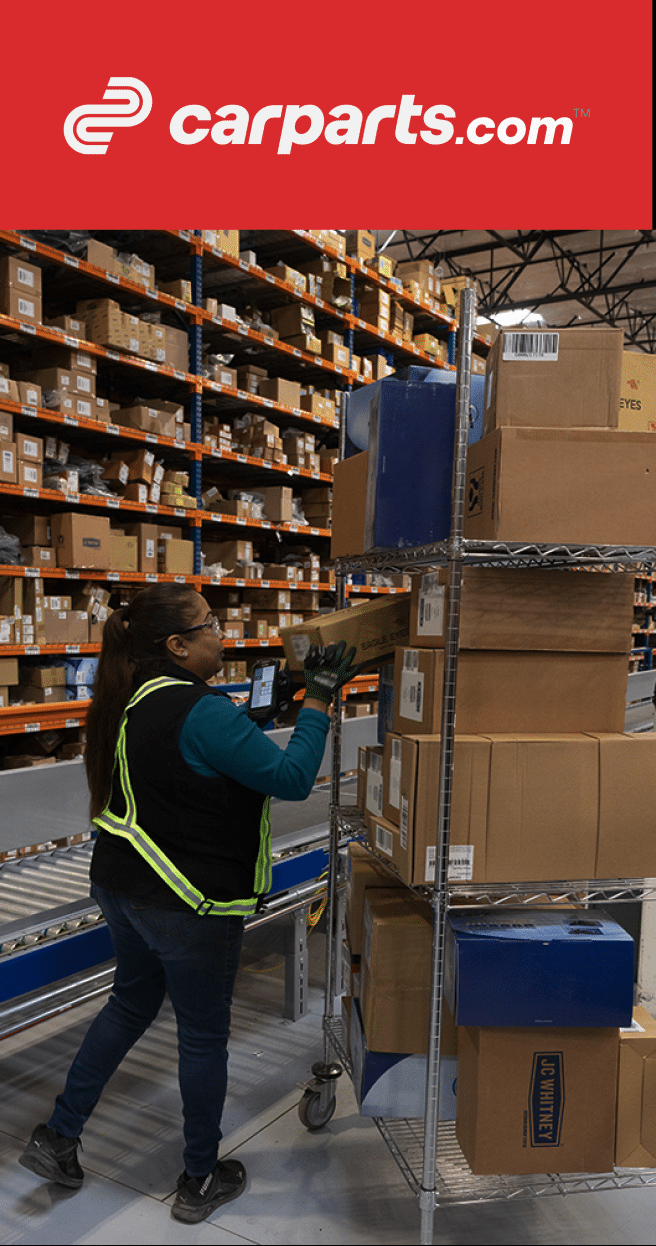
For many 3PLs and eCommerce retailers, the key to realizing greater productivity across their operations is warehouse automation. At its most basic level, warehouse automation minimizes or even eliminates the amount of time and effort that order-picking associates spend walking the aisles and picking individual SKUs in the warehouse. Walking is a low-value activity that detracts from the number of orders that workers can pick per hour. In fact, studies show that warehouse associates can spend as much as half of their work time walking during order picking.
There are two main order fulfillment automation methods: Goods-to-Person and Person-to-Goods. In Goods-to-Person (GTP) automation, warehouse robots brings picked products to a mostly stationary associate, nearly eliminating walking and unproductive time. In Person-to-Goods (PTG), associates travel through the aisles to find and pick orders. The use of robot technology and software cuts down on their walking and increases pick rates.
In this article, we’ll define each of these picking automation options and spell out the key differences between them.
What Is Goods-to-Person (GTP) Automation?

inVia Picker Robots. Source: inVia Robotics
Goods-to-Person (GTP) is a warehouse automation solution in which products are brought to a person by a fixed or Autonomous Mobile Robots (AMRs). Associates receive the items needed to prepare an order at their pick stations without having to move in any meaningful way from their location.
There is a variety of Goods-To-Person technologies. On one end are large, fixed robotic systems like Automated Storage and Retrieval Systems (ASRS), which deliver high productivity rates and provide high storage density. The ASRS pulls and delivers the required items, usually in a tray or tote, to the picker who chooses the items needed. The system then automatically returns the boxes to the rack.
As a large, fixed robotic system, an ASRS delivers high productivity rates, reduces the amount of foot traffic for warehouse workers, and provides high storage density. However, these systems are expensive and require a considerable investment in infrastructure.
On the other end of large robotic systems are mobile automation solutions, such as those offered by inVia, which use Autonomous Mobile Robots (AMRs). These warehouse automation solutions are more scalable and flexible. AMRs require far less capital investment and generally use or adapt warehouse’s existing infrastructure.
— Racks-to-Person vs. Tote-to-Person Automation

There are two Mobile Goods-to-Person automation approaches. “Racks-to-Person” method uses low-profile robots to go underneath an entire shelf of goods, lift up the shelving unit and carry it to an order-picking station. Associates are alerted to the items to pick and appropriate bins to stow items. The disadvantage to a racks-to-person approach is that people and machines often work at different paces. Racks and goods can pile up while an associate takes a break. During peak periods, robots may bring more racks to the order-picking station than the people can handle, and again, the result is a bottleneck.
“Tote-to-Person” method uses AMRs to bring a specific tote rather than an entire rack. With inVia’s Tote-to-Person (or more specifically “Tote-to-PickerWall“) system, robots remove a tote from a shelf and bring it back to a put-wall and stow it in a shelf in the PickerWall. Later, picker associates pick items from the tote. Travel for the associate is limited to a small area, which saves time and injury risk from prolonged warehouse travel. The inVia system decouples human and robotic processes, allowing humans to work in bursts, while robots can operate 24/7.
What Is Person-to-Goods (PTG) Automation?

As the name suggests, Person-to-Goods picking involves workers traveling the aisles of a warehouse or retail facility to manually select items for an order and then bringing them to an area for packing. Today, many Autonomous Mobile Robots (AMR) solutions on the market are based on Person-to-Goods fulfillment and operate as smart carts powered by software. The order picker meets the robot at the pick site, removes items from the shelf, puts them into the smart cart, then each proceeds separately to another pick location. People walk less because they tend to concentrate on a warehouse zone, say an aisle or two, which means less foot travel. The smart carts handle most of the travel including the longer return route to the packing station when all items in the order have been picked.
While there is a certain amount of inefficiency with all warehouse walking by associates, WES software and AI can help cut down on walk time and improve picking productivity. Associates picking orders can be notified of the next pick location with wearable technology such as wrist displays or smart glasses. Technologies such as Pick-to-light or inVia’s Pick-to-Color guide workers to the exact location of the SKU, while AI software can significantly cut travel time.
Key Differences Between PTG vs GTP Automation
— Increase in Productivity

Both automation solutions help increase productivity. As person-to-goods automation still involves people going out into the aisles to select items, productivity increases over manual picking can reach 2-3x.
Goods-to-person automation uses a variety of automation technologies that bring the goods to the order picker. Associates remain at their pick stations while the software organizes their tasks. Most deliver between 3-4x improvements in productivity, although some require major capital investments in infrastructure and robotic systems.
inVia’s robotics-as-a-service solution delivers an average 5x productivity boost with minimal CapEx. It can be deployed using existing infrastructure while delivering pick rates that exceed those of ASRS.
— Pick Rate
The rate at which warehouse pickers pick is an important metric of productivity. All warehouse automation solutions strive to deliver improved pick rates. PTG automation (smart cart AMRs) tends to result in pick rates that can reach 100-200 Units Per Hour (UPH). GTP solutions generally average pick rate speeds of 350 UPH.
inVia PickerWall system results in an average 350-450 UPH pick rate and can help realize bursts up to 1,000 UPH.
— Warehouse Walking
Traditional order picking requires a worker to travel to each SKU around the warehouse and pick it, on a one-by-one basis. This approach requires a tremendous amount of warehouse walking, as much as 10 miles per day by many estimates. Intelligent WES software and PTG automation can cut walking even by half.
With a GTP approach, associates remain at their workstations and the items for each order are brought to them for sorting and fulfillment. WES software coordinates the entire operation, syncing the use of AMRs and other automated components to deliver a box or container to workers at their posts. Workers travel just within their prescribed work areas, minimizing warehouse walking.
Using a GTP tote-to-PickerWall approach, inVia helps 3PLs and warehouse employees realize a 90% decrease in walking. Workers walk on average less than 1 mile to pick SKUs from the inVia PickerWall versus 12 miles in traditional picking.
— Order Accuracy
The traditional method of filling orders often involves sending workers to different zones to find products to match SKUs. Besides the miles of unproductive walking, replenishment and fulfillment can lead to human errors because of distractions and travel demands.
Automation can improve the error rate significantly. Order accuracy is a key benefit of GTP systems which deliver the correct product directly to the workstations of order pickers, reducing the chances for mis-picks. In fact, most GTP systems easily exceed 99% order accuracy. inVia’s AMRs robotic precision ensures 99.9% accuracy.
— Quick ROI
Many new warehouse automation and robotics solutions require some level of change and investment in current facilities. 3PL providers and e-commerce retailers are conscious of managing their upfront investment in warehouse automaton and keeping CapEx at manageable levels to ensure they can provide better pricing to customers. They want to avoid large infrastructure payments because they and their customers can’t justify amortizing the cost of capital-intensive systems over what are often relatively short time horizons of just a few years.
The most expensive option, which entails the greatest changes, is ASRS which involves large-scale equipment and facility modifications. AMR solutions can vary in terms of cost and infrastructure change. In many cases, however, GTP approaches can lead to relatively swift ROI due to a reduction in picker errors during manual product management and higher order dispatch rates.
inVia’s subscription-based model offers minimized CapEx, pay per performance investment, with near real-time ROI.
Conclusion
Person-to-Gods and Goods-to-Person warehouse automation systems each offer a range of benefits to reduce unproductive walking time and increase productivity and performance. GTP automation, however, offers far greater favorable results in the areas that matter most to 3PLs and warehouse owners: speeding orders, sharply boosting pick rates, reducing idle time, increasing productivity and accelerating ROI.
Having the robots do the traveling reduces the cost-per-pick and saves wear and tear on associates. This factor alone significantly boosts productivity, reduces labor costs and increases employee output.
Request a demo to learn more about inVia’s Goods-to-Person automation system.

